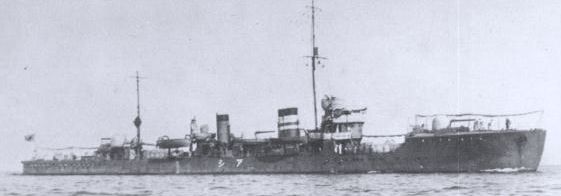© 2007 Bob Hackett, Sander Kingsepp and Peter Cundall
24 May 1919:
A MOMI-class destroyer is ordered from Kawasaki Heavy Industies Ltd. shipyard and named AOI.
1 April 1920:
Kobe. Laid down.
9 November 1920:
Launched.
20 November 1920:
LtCdr (later Rear Admiral) Chiya Sadae (34) is appointed Chief Equipping Officer.
20 December 1920:
Completed. LtCdr Chiya is the Commanding Officer.
1 December 1921:
An unknown officer assumes command.
20 July 1922:
LtCdr (later Rear Admiral) Fujimori Seiichiro (37) assumes command.
19 August 1922:
An unknown officer assumes command.
6 January 1925:
LtCdr (Rear Admiral, posthumously) Suzuki Kozo (36) assumes command.
20 April 1925:
An unknown officer assumes command.
15 October 1926:
Lt (Rear Admiral, posthumously) Sugimoto Michio (41) assumes command.
1 December 1926:
Lt Sugimoto is promoted LtCdr.
1 November 1927:
LtCdr (later Rear Admiral) Itagaki Sakan (39) assumes command.
10 December 1928:
An unknown officer assumes command.
1 December 1932:
LtCdr (Rear Admiral, posthumously) Setoyama Yasuhide (45) assumes command.
1 November 1933:
An unknown officer assumes command.
1940:
Kure Navy Yard. AOI undergoes modifications. One of her
three Kampon boilers is removed reducing her speed to 18 knots. Additionally,
her torpedo tubes, aft 4.7-inch/45 cal main gun and minesweeping gear are
removed. 25mm AA guns and depth charge racks and throwers are fitted. Extra
ballast is added to compensate for the loss in weight and to increase stability.
The changes increase her displacement to 935-tons.
21 October 1940:
Modifications are completed.
1 April 1941:
AOI is reclassified as a special duty patrol boat and
renumbered 32.
20 November 1941:
Reassigned to Captain Nishikawa Hayami's Patrol Boat Squadron 1.
29 November 1941:
Departs Truk for Kwajalein.
2 December 1941: Operation "Z":
PB-32 receives the signal
"Niitakayama nobore (Climb Mt. Niitaka) 1208" from the Combined Fleet. This
signifies that X-Day hostilities will commence on 8 December (Japan time).
3 December 1941:
Arrives at Roi-Namur, Kwajalein,
8 December 1941: The Invasion of Wake Island:
PB-32 and PB-33 depart
Roi-Namur to participates in the first attack of Wake with Rear Admiral (Vice Admiral, posthumously) Kajioka Sadamichi's (former CO of KISO) Attack Force's DesRon 6ís light cruiser YUBARI,
DesDiv 29's OITE and HAYATE and DesDiv 30's KISARAGI, MUTSUKI, YAYOI and
MOCHIZUKI, CruDiv 18ís light cruisers TATSUTA and TENRYU, submarine depot ship
JINGEI and armed merchant cruisers KONGO and KINRYU MARUs.
11 December 1941:
Two miles SW of Wake Island. DesDiv 29's HAYATE and
OITE close to bombard Wilkes Island, but HAYATE takes three direct hits from
salvos of Marine 5-inch guns. At 0652, HAYATE blows up and sinks with her entire
crew. A near-miss damages OITE. Later, DesDiv 30's YAYOI is also hit by a 5-inch
shell.
30 miles SW of Wake. At 0724, four Marine Grumman F4F -3"Wildcats" strafe
TENRYU and damage three torpedoes on her deck. Another Wildcat strafes TATSUTA
Captain Henry T. Elrod, USMC, hits DesDiv 30's KISARAGI with a 100-lb. bomb that
probably detonates her depth charges. At 0731, she blows up and sinks with her
entire crew. That morning, a dejected Rear Admiral Kajioka orders his Attack
Force to withdraw and return to Kwajalein.
13 December 1941:
Returns to Roi.
21 December 1941: The Second Invasion of Wake Island:
PB-32 and PB-33
depart Roi with the rest of the Attack Force. The Attack Force is joined by CarDiv
2's HIRYU and SORYU, Rear Admiral (later Vice Admiral) Abe Hiroaki's (former CO
of FUSO) CruDiv 8's TONE and CHIKUMA, DesDiv 17's URAKAZE and TANIKAZE that are detached
from Vice Admiral (Admiral, posthumously) Nagumo Chuichi's (former CO of KIRISHIMA) Pearl Harbor Striking Force enroute back to Japan. The Attack Force is also joined by Rear Admiral (Vice Admiral, posthumously) Goto Aritomo's (former CO of MUTSU) CruDiv 6's AOBA, KINUGASA, KAKO and FURUTAKA, CruDiv 18's KIYOKAWA MARU and DesDiv 29's ASANAGI and YUNAGI.
22 December 1941:
Participates in the second invasion of Wake with PB-33.
23 December 1941:
PB-32 carries part of Lt Uchida Kinischiís 1st Company of the Maizuru Second Special Naval Landing Force (SNLF). At about 0245, to ensure the SNLF troops get ashore, PB-32 is deliberately run aground on the south shore of the atoll near the west end of the airstrip at 19-17N, 166-37E.
A USMC shore battery's 3-inch gun damages PB-33 and sets her afire. The flames illuminate PB-32 farther west along the beach. The Marines shift fire and three-inch shells hit PB-32 at 19-17N, 166-37E. The crews from both PB-32 and PB-33 join the SNLF troops landing on the island. Later that day, after a magnificent, but hopeless stand, Wake's grossly outnumbered American garrison is overwhelmed and forced to surrender.
1942:
After the Japanese secure the island, they make no attempt to salvage PB-32. Wake Island is renamed Otori Jima by the Japanese.
15 January 1942:
Removed from the Navy List.
4 September 1945:
PB-32's hulk remains in place when American forces reoccupy the island.
-Bob Hackett, Sander Kingsepp and Peter Cundall
Back to
Patrol Boat Page



